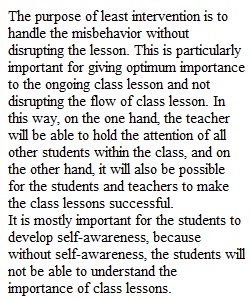


Q Assignment Instructions Instructions Submission of your graded assignment is due by 11:59 p.m. Central time on Sunday. Assignments should be created and submitted as an attachment in one of the following forms: (MS Word or PDF) as AssignmentTitle_LastnameFirstInitial.docx or .pdf. View the general instructions below for assignment requirements, formatting expectations, and grading rubric applied to all CM Assignment Sections. This information can also be found in the General Instructions for Classroom Management Assignments Specific Instructions for Module 5 CM Assignment, which is based on Chapters 9 & 10 Chapter 9: Responding to Inappropriate Behavior After reading Chapter 9, use what you have learned from the chapter to answer the prompt questions below. Chapter 9 Details: Despite your best efforts, there will be times when you will have to address misbehavior in your classroom. Often, students bring chronic forms of misbehavior with them. They may have developed them at home or from a previous class; either way, you need to deal with them as quickly and effectively as possible. In these cases, the best defense is a good offense. If you are already looking for these misbehaviors and have a plan in place, you can handle them quite effectively. 1. Describe the principle of least intervention (p. 164) in your own words. 2. Define self-awareness and describe why it is important to help students develop this (find an outside source). 3. Develop a long-term response plan (pp. 164–176) for chronic misbehavior (pp. 176-179). o Describe how you will use various responses discussed by Burden to address seven of the 10 misbehaviors listed (tattling, clowning, cheating, lying, stealing, profanity, rudeness to the teacher, defiance/hostility to the teacher, failure to do work, and inappropriate use of electronic devices). o You must respond to cheating, lying, failure to work (class and homework), and rudeness toward the teacher. You choose the other three. o Include at least two logical or natural consequences for each of the seven misbehaviors. 4. Describe how you will address bullying in your class (pp. 180–183). List the steps of what you will do when you encounter bullying. Chapter 10: Dealing with Challenging or Violent Students After reading Chapter 10, use what you have learned from the chapter to answer the prompt questions below. Use Chapter 10 Details: Hopefully you will never have a challenging or violent student in your class, but you probably will. As with the previous section, the best defense is a good offense, and planning is a good start to that offense. Most of this section will be in the form of tables because if you need this information, you need to be able to access it easily. Consider this as you put your tables together and label them appropriately. 1. Use Table 10.1 (p. 187) to help you. There are five behavioral categories listed in the table (1a, 1b, 2a, 2b, 2c). Name each of the five categories and give a short definition for each. Then list each of the behaviors given for each category and identify the ones in each list you think you might see in your students by giving them a different color. For example, you might produce a table that looks like this: Characteristic behaviors of challenging or violent students Definition/Description Specific behaviors and those I think I might see in my classroom 2. List six outside influences on the behaviors of challenging or violent students (pp. 188–189). Identify the outside influences you suspect some of your students may deal with by making the font a different color. 3. Create a three-column table with the following in list form: Early Signs of Serious Problems (pp. 189–190), Early Warning Signs (Table 10.2), and Imminent Signs of Violence (Table 10.2). Follow the table with a narrative explaining why it is important to identify these symptoms early in students. 4. Use the Planning to Work with Challenging or Violent Students section (pp. 190–192) to produce the beginnings of a plan to respond to challenging students. Produce a bulleted list of the six suggestions with a short explanation of why each is important. 5. Create a table to summarize the sections of Teaching Students Alternatives to Disruption and Violence (pp. 192–197). Identify the alternatives you would likely use by making the font a different color. 6. Create a second table to summarize Responding to Disruptive or Violent Behavior (pp. 197–204). Identify the responses you would likely use by making the font a different color. I know this section is long, but it is very important. When something like this happens, you need to at least know the basics. ________________________________________ Reminder every CM Assignment needs to have an introduction, body (response to question prompts for both chapters), conclusion (summary of both chapters if two chapters are assigned), and reference page (adhere to APA 7th Style). Do not use direct quotes, paraphrase only! Estimated time for completion: 10 hours for reading and writing reflection
View Related Questions